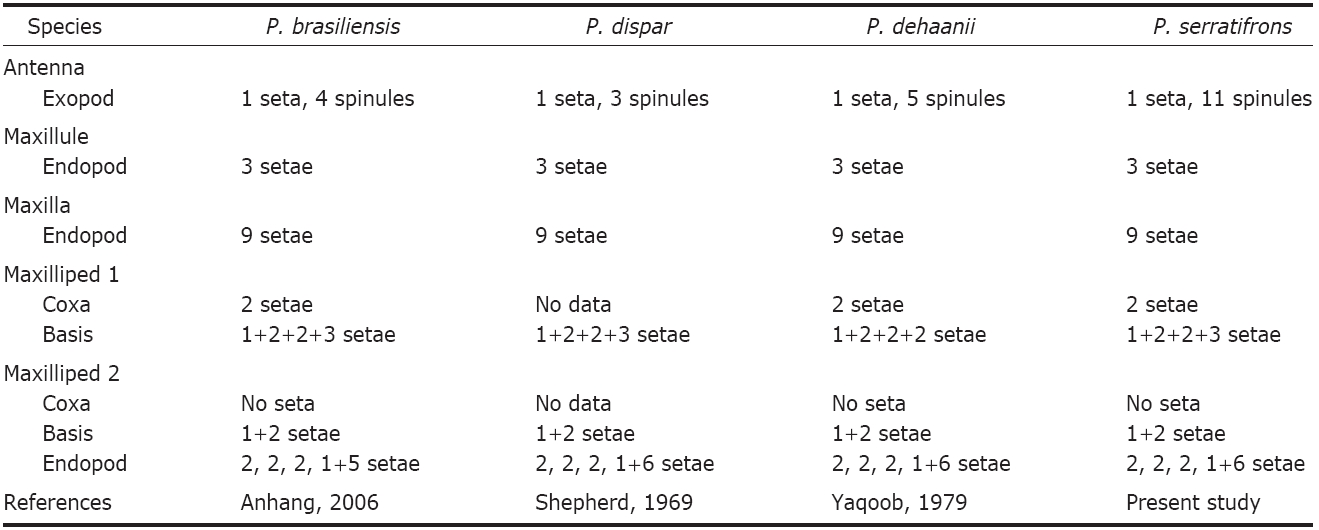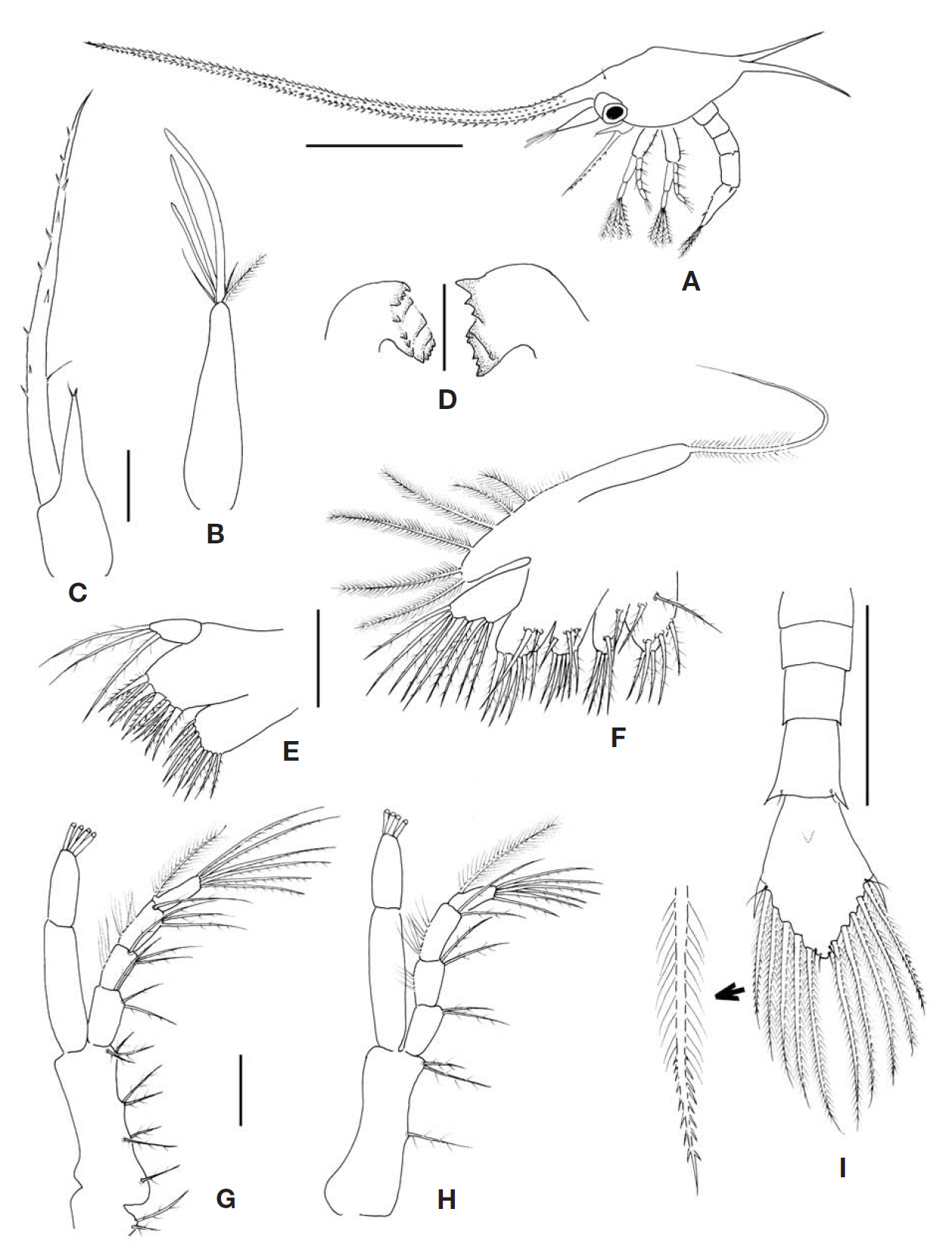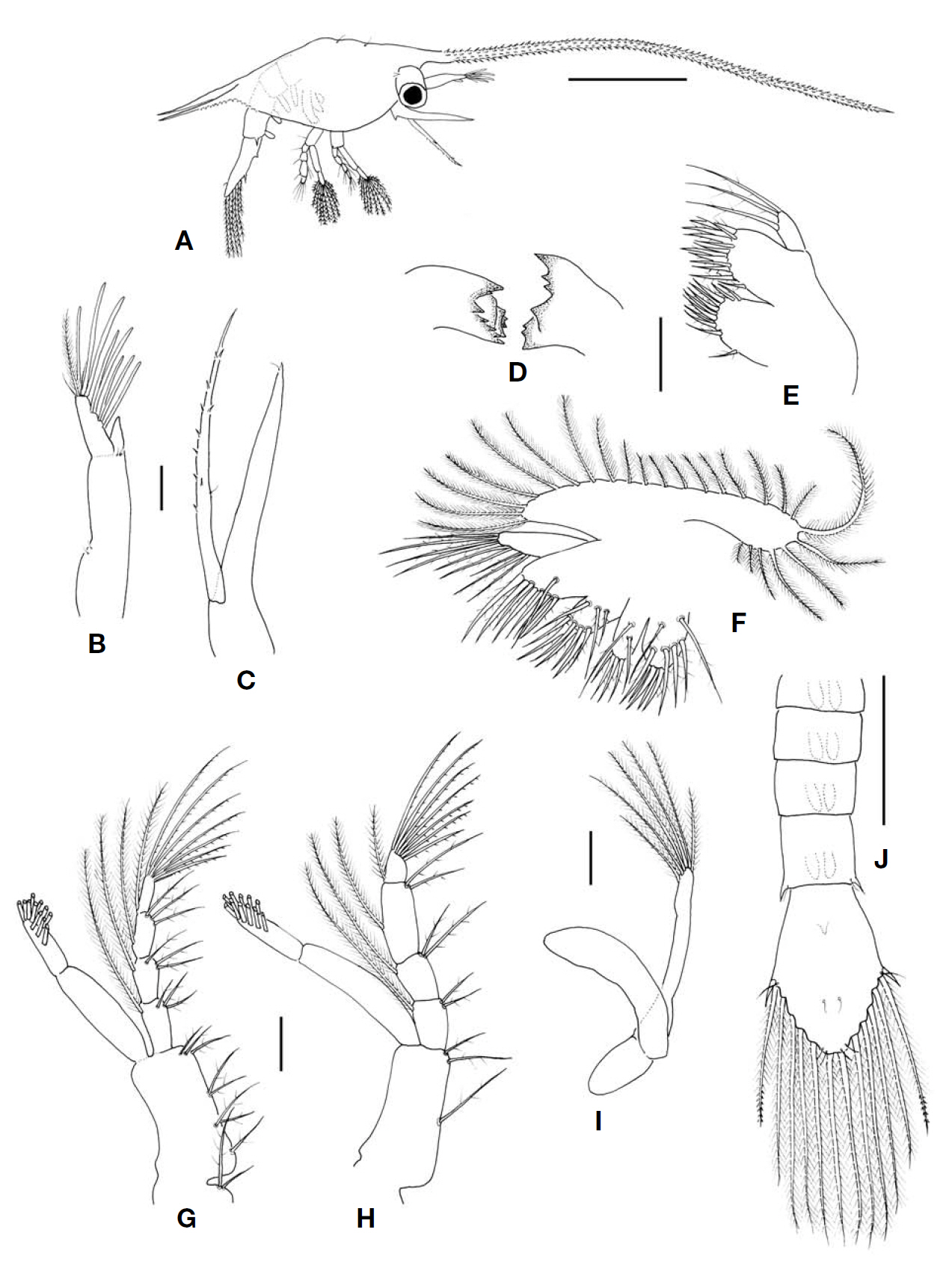



Crabs of the family Porcellanidae include ten species belonging to seven genera in Korea:
In the present paper, the zoeal stages of
An ovigerous female of
Zoeal development of
Size: CL, 0.96±0.03 mm; RSL, 3.39±0.02 mm; PSL, 0.67±0.04 mm.
Carapace (Fig.1 A). Typically porcellanid, with pair of small setae on dorsal surface, with 1 extremely elongate rostral and 2 posterior carapace spines; former heavily armed overall with four rows of spinules to its tip and up to 3.5 times CL, while latter about 0.7 times CL; both posterior spines unarmed; lower margin of posterior carapace naked.Eyes stalked.
Antennule (Fig.1 B). Elongate and slightly swollen, with 3 aesthetascs, 2 simple setae, and 1 plumose seta distally; no endopod bud.
Antenna (Fig. 1C). Endopod fused to protopod, spinous distally, with single short subterminal seta; exopod slender rod, about 2.6 times longer than protopod, with submedial seta and 11 small spinules.
Mandibles (Fig.1 D). Asymmetrical, with heavily dentate processes; no palp.
Maxillule (Fig.1 E). Coxal and basial endites with 9 and 10 setae, respectively; endopod with 3 setae.
Maxilla (Fig.1 F). Coxal endite with 7+5 setae; basial endite with 8+8 setae; endopod with 9 setae in 3 groups of 3+2+4; scaphognathite with 6 marginal plumose setae and long plumose posterior process.
First maxilliped (Fig.1 G). Coxa with 2 setae; basis setae progressing distally 1+2+2+3; endopod 4-segmented, with 3, 3, 3, 1 plumose +6 distal setae; exopod 2-segmented, with 4 long natatory setae distally.
Second maxilliped (Fig.1 H). Coxa without seta; basis setae 1+2; endopod 4-segmented, with 2, 2, 2, 1 plumose+6 distal setae; exopod as in first maxilliped.
Abdomen (Fig.1 I). Somite 5 with lateral spine, pair of setae on posterodorsal margin laterally.
Telson (Fig.1 I). Seven pairs of posterior processes present:first (outermost) process stout spine, second short plumose seta, from third to seventh processes long and plumose, third armed with distinct hooklets or hooklike spinules distally; 2 pairs of short setae found on posterior central prominence dorsally; anal spine present on ventral surface.
Size: CL, 1.61±0.05 mm; RSL, 3.99±0.58 mm; PSL, 0.61±0.07 mm.
Carapace (Fig.2 A). Two pairs of small setae on dorsal surface, both posterior spines bearing a few ventral pointed spinelets near their basal margin; lower margin of posterior carapace margin serrate; postorbital spine present.
Antennule (Fig.2 B). Slightly segmented, with 8 aesthetascs, 2 simple setae and 1 plumose seta; endopod bud present.
Antenna (Fig.2 C). Endopod developed, slightly shorter than exopod.
Mandibles (Fig.2 D). Unchanged.
Maxillule (Fig.2 E). Coxal and basial endites with 11 and 12 setae, respectively.
Maxilla (Fig.2 F). Coxal endite with 10+6 setae; basial endite with 10+9 setae; scaphognathite with 25 plumose setae around outer margin.
First maxilliped (Fig.1 G). Endopod setae 1 plumose+3, 1 plumose+3, 1 plumose+3, 1 plumose+7 distal setae; exopod with 11 long natatory setae distally.
Second maxilliped (Fig.1 H). Endopod setae 1 plumose+2,1 plumose+2, 1 plumose+2, 1 plumose+7 distal setae;exopod as in first maxilliped.
Third maxilliped (Fig.2 I). Endopod naked; exopod with 6 long plumose setae.
Pereiopods (Fig.2 A). Present as buds.
Abdomen (Fig.2 J). Somites 2-5 with pleopod buds.
Telson (Fig.2 J). Pair of short setae on dorsal surface submedially; 8 pairs of posterior processes present, eighth process (innermost) long and plumose.
In zooplankton samples, the porcellanid zoeae are easily distinguished from other decapod zoeae by extremely elongated rostral carapace spines and a pair of posterior spines. At the generic level, a key to them was proposed by Shepherd (1969), who described the genus

Comparisons of the first zoeal characteristics of the four species of Pisidia in Porcellanidae
Ten porcellanid species have been reported in Korean waters (The Korean Society of Systematic Zoology, 1997; Ko, 2003, 2006), however, the zoeae of only six of these species (
>
A provisional key to the known zoeae of six Korean porcellanid crabs
1. Exopod of antenna with only 3 or 4 spinules ????????????????2
- Exopod of antenna more than 1 seta ???????????????????????????3
2. Rostral spine length approximately 7 mm in first stage ????
???????????????????????????????????????????????????Pachycheles hertwigi
- Rostral spine length less than 6 mm in first stage, more
than 7 mm in second stage ???????????????????????????P. stevensii
3. Exopod of antenna with 1 seta ????????????????????????????????????4
- Exopod of antenna with 2 or 3 setae ????????????????????????????5
4. Exopod of antenna with 5 spinules????Enosteoides ornata
- Exopod of antenna with 11 spinules ????Pisidia serratifrons
5. Exopod of antenna without spinule ????????????????????????????????
??????????????????????????????????????????????????Petrolisthes japonicus
- Exopod of antenna with 2 spinules??????????????P. coccineus


